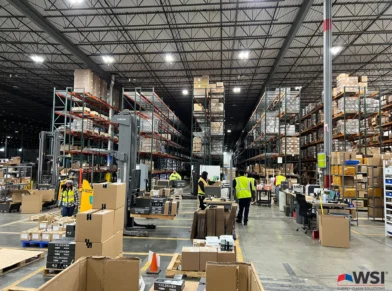Website Design and SEO: How Design Impacts Your Search Rankings

Imagine you’re searching for a product or service online, and you click on a website that takes forever to load, has a cluttered layout, and is not the easiest to navigate. Frustrating, right?
Such experiences not only drive you away but also leave a lasting impact on your perception of the brand. This scenario underscores the critical role of website design in determining user experiences and, ultimately, search engine rankings.
A well-crafted website is a powerful tool that can influence your SEO traffic and enhance conversion rates. As the online gateway to your business, your website’s design should seamlessly align with your business goals, product offerings, and service structure to create an immersive and meaningful experience for visitors.
The Intersection of Design and Search Engine Rankings
The realm of website design is not confined merely to aesthetics and visual appeal. It’s intricately linked to your website’s performance and its ability to drive success.
A staggering 75% of a company’s credibility can hinge on its website design, underscoring the critical role it plays in shaping user perception and building trust. The significance of website design’s impact on user engagement cannot be overstated. And a site’s ability to engage users is an important SEO ranking factor.
Another factor that influences search engine rankings is speed. Research shows that 40% of users are liable to abandon a website that takes more than three seconds to load. Impressions are formed quickly in the digital realm, with visitors taking less than 50 milliseconds to decide if a website resonates with them.
When millions of websites are vying for attention, a site’s optimization for search determines how high it shows up in the results. SEO is what sets the best apart from the rest and web design plays a critically important role here.
Understanding the Basics of SEO
SEO is the backbone of online success, determining how easily your website is discovered by users searching for relevant content. Increased visibility translates to higher organic traffic, which is crucial for attracting potential customers and driving conversions.
Defining SEO and its Significance
SEO includes a set of smart methods to improve your website’s position in search engine results. When keywords related to your business are searched, you want your site to show up among the top results. This brings more traffic to your website which means more chances for business growth. SEO is not only about driving traffic but also about attracting the right kind of traffic—users who are actively seeking the products or services your business offers.
Explaining Key Elements of SEO
Several essential elements contribute to effective SEO, including keywords, backlinks, and user experience.
- Including keywords in your website’s content helps search engines figure out what your pages are about.
- Backlinks, or inbound links, are links from other websites that point to yours. High-quality backlinks from trustworthy sources tell search engines that your content is useful and reliable.
- User experience encompasses multiple aspects of your website’s design, functionality, and ease of use, all of which impact how visitors interact with your site, how long they stay, and whether or not they come back.
We’ll discuss other important elements of SEO later in the article.
The Role of Website Design in Optimization
Website design plays a significant role in optimizing for these key SEO ranking factors. An intelligently designed website facilitates smooth navigation, making it easier to explore and understand your content. Properly organized menus, clear calls-to-action, and intuitive layouts enhance user experience, leading to longer session lengths and lower bounce rates. An aesthetically pleasing and responsive design also enhances user engagement, encouraging visitors to explore more pages and interact with your content, all of which contribute to improved SEO performance.
The Connection Between Website Design and SEO
Beyond being visually appealing, your website’s design directly influences its search engine ranking and user engagement. Businesses can unlock the true potential of their online presence and stand out in the competitive digital landscape by harmonizing design principles with SEO strategies.
Responsive Design and Mobile Optimization
Responsive design and mobile optimization are no longer merely design alternatives. They have become essential for optimizing SEO effectiveness due to the explosive growth in mobile device usage.
A responsively designed website changes depending on the size of screen it’s viewed on, ensuring it’s easy to use on all devices. Search engines favor websites that work well on mobile and rank them higher in mobile searches to give users the best experience possible. Adopting responsive design makes your website easy to use, regardless of device. This results in stronger user engagement, longer website visits, and fewer single-page visits (bounces).
Website Speed and Its SEO Impact
A website’s page load speed greatly affects its usability. Sites that are slow to load frustrate users, making them more likely to leave. Research shows pages that take five seconds to load have a 90% higher bounce (exit) rate than those taking only one second. Search engines recognize this and incorporate page speed as a ranking factor, knowing that faster sites lead to better user experiences.
User-Friendly Navigation and Intuitive Site Structure
User experience and SEO are closely intertwined. A well-designed navigation menu guides users through your website, helping them find the information they need swiftly and effortlessly. This not only enhances user experience but also aids search engine crawlers in indexing your content effectively. A clear and logical site structure organizes your content optimally, making it effortless for users to navigate and search engines to understand the hierarchy and relationships between different pages. As a result, user-friendly navigation and intuitive site structure contribute to lower bounce rates, longer dwell times, and improved SEO rankings.
Site Architecture and URL Structure for Crawlers
The architecture of your website and the way its URLs are constructed both have a substantial impact on how search engine crawlers navigate and index your content. A well-organized site architecture ensures that every page is accessible within a few clicks, preventing important pages from being buried deep within the site.
Descriptive, keyword-rich, user-friendly URLs help search engines and users understand the topic of the page. Clean URL structures not only improve click-through rates but also facilitate better crawling and indexing by search engines. You enhance the visibility of your content and improve your SEO rankings by creating a site architecture and URL structure that are conducive to easy exploration.
Website Design’s Role in Content and SEO
The synergy between content and design is evident in the way website layout, typography, and multimedia elements enhance content readability and user engagement.
Elevating SEO with High-Quality Relevant Content
The best websites are built around high-quality, relevant content that provides value to visitors. Search engines are becoming increasingly adept at discerning sites that contain valuable information from those that do not. Websites that provide insightful and well-researched content are rewarded with higher rankings. Content that answers common questions, offers solutions, and presents authoritative insights establishes a website’s credibility and fosters trust among visitors.
Enhancing Readability and Engagement Through Design
Website design plays a crucial role in guiding users through content, ensuring that the information is engaging. Thoughtful design choices such as clear typography, appropriate font sizes, and well-structured layouts enhance content’s readability. When website design incorporates visually appealing, easy to read content, users tend to linger and explore further.
Crafting SEO-Friendly Content with Proper Formatting and Meta Tags
Proper formatting and the strategic use of meta tags are signals for search engine crawlers, helping them navigate and understand the content’s relevance. Headings and subheadings not only improve readability for users but also provide a hierarchical structure that search engines can interpret. Carefully crafted meta tags offer brief overviews of the content, impacting how many people click on your website from search results.
Multimedia Elements Enhancing SEO Impact through Visuals
Multimedia elements such as images, videos, and infographics are not only attention-grabbing but also contribute significantly to SEO. Properly optimized images with descriptive alt text can be indexed by search engines, enhancing the content’s relevance. Videos increase user engagement, leading to longer visits, while infographics provide concise information in a visually appealing format and are excellent for generating external links.
The Essence of Technical SEO in Website Design
Technical SEO forms the backbone of a website’s search engine performance – a technical SEO audit often uncovers hidden problems preventing your website from loading quickly or indexing the right pages. Let’s explore the key facets of technical SEO and how they synergize with the art of website design to shape a site’s digital footprint.
Unveiling the Significance of Technical SEO and Its Link to Website Design
Technical SEO involves improving a website’s technical aspects to make it more visible to search engines. This intricate process plays a pivotal role in determining how search engines perceive and rank a site. The connection between technical SEO and website design is paramount, as design choices directly influence how search engine crawlers interact with the site’s underlying structure.
The Power of Proper HTML Coding and Pristine Website Structure
Proper HTML coding and a well-structured website layout are the building blocks of technical SEO. Structured HTML helps search engine crawlers easily grasp and organize a site’s content. A clutter-free website structure not only aids search engines in navigating the site but also enhances user experience by providing an organized and intuitive layout.
Unmasking the Role of Meta Tags, Alt Attributes, and Schema Markup in SEO
Meta tags, alt attributes, and schema markup are the unsung heroes of technical SEO. Meta tags provide succinct descriptions of a page’s content, helping search engines understand its context. Alt attributes enrich images with descriptive text, improving accessibility and aiding search engines in comprehending visual content. Schema markup, a form of structured data, adds an extra layer of context to certain content elements, enabling search engines to better categorize it and to display rich snippets in search results.
Illuminating the Significance of XML Sitemaps, Robots.txt, and Canonical Tags
XML sitemaps act as guides for search engines, directing them to essential pages on a website. They ensure that no valuable content goes unnoticed during the crawling process. Robots.txt files set rules for what parts of a site search engines should or shouldn’t explore. Canonical tags show search engines the preferred version of repeated content, preventing confusion.
Elevating User Experience for Enhanced SEO
User experience is pivotal for SEO success. Effective website design offers intuitive navigation, engaging content, and distinct calls to action, driving user engagement.
Unveiling the Synergy Between User Experience and SEO Rankings
Search engines emphasize providing users with valuable, relevant, and user-friendly content. As a result, a positive user experience is important in determining how high a website shows up in search results. Search engines look at bounce rate, time spent on the site, and click-through rates to see if users are satisfied and interested.
The Role of Website Design in Crafting a Seamless User Experience
Website design directs visitors through a digital journey that aligns with their needs and expectations. A well-designed website offers intuitive navigation, easy-to-digest content, and lucid calls to action. Effective website design practices enable businesses to direct users toward their intended objectives, whether those objectives entail making purchases, subscribing to newsletters, or accessing informative resources.
Spotlighting the Importance of Easy Navigation, Intuitive Layouts, and Clear Calls-to-Action
Easy navigation is the compass that guides users through a website, allowing them to explore content effortlessly. Intuitive layouts ensure that visitors can locate desired information without frustration, enhancing engagement and reducing bounce rates. Direct calls-to-action act as signposts, encouraging users to take desired actions like requesting a quote, contacting the company, or completing a transaction. These design elements collectively contribute to a seamless and satisfying user experience.
Recognizing the Nexus Between Mobile-Friendliness, Page Load Speed, and User Experience
Websites that are responsive and adaptable to various screen sizes provide an optimal browsing experience, satisfying users and search engines alike. Page load speed is equally critical, as pages that take a long time to load can make users frustrated and more likely to leave quickly. Since search engines prioritize delivering swift and relevant results, fast-loading pages receive a boost in rankings, further emphasizing the importance of mobile-friendliness and speed optimization.
SEO-Optimized Website Design Best Practices
Discover the art of harmonizing design and SEO for exceptional digital impact. Start by doing smart keyword research, then naturally use these important words in your website’s content, headings, and descriptions.
Navigating the Path to SEO Excellence with Actionable Design Tips
When it comes to optimizing website design for SEO rankings, a strategic approach can yield remarkable results. Begin by conducting keyword research. Integrate these keywords naturally into your content, headers, and meta descriptions to enhance search engine visibility. Furthermore, leverage descriptive alt text for images to make your content accessible and indexable for search engines.
Enhancing User Experience and SEO with Responsive Design and Mobile Optimization
As more people use mobile devices to browse websites, a responsive design makes sure your site looks good on all screen sizes. This improves how users feel and helps your site rank better on search engines. Businesses can reach more people and meet search engines’ mobile-first rules by focusing on mobile optimization.
The Need for Optimal Website Speed to Accelerate Performance
Your website’s speed and performance affect how users feel and how well it ranks on search engines. Pages that load slowly can make users leave and hurt your website’s search ranking by causing higher bounce rates. To enhance website speed, employ strategies such as optimizing image sizes, using browser caching, and minimizing server response time. A faster website provides a better user experience and earns favor with search engines, ultimately enhancing your search rankings.
Guiding Users and Search Engines through Navigational Ease and Structural Clarity
Intuitive navigation and a clear site structure are user-friendly and crucial for search engine crawlers to index your website effectively. Arrange your content logically, incorporating descriptive headings to lead visitors through your site’s offerings. Integrate breadcrumbs for hierarchical navigation, allowing users to comprehend page relationships. A well-structured site ensures a seamless experience for users and facilitates search engine crawlability.
Elevating Quality and Relevance with Content
Create valuable and relevant content that meets users’ needs and answers questions. Naturally include keywords, avoiding excessive usage. Consider producing in-depth, long-form content that thoroughly explores subjects, showcasing expertise and credibility. Employ proper formatting, bullet points, and subheadings to enhance content readability, thereby boosting user engagement and search rankings.
The Power of Clean Code and Technical SEO Optimization
Beneath the surface of a visually appealing website lies the foundation of clean code and technical SEO optimization. Streamlined code enhances website performance, leading to faster load times and improved user experience. Use schema markup to give search engines organized information, making important details stand out in search results. Also, make sure to do proper canonicalization, improve XML sitemaps, and use robots.txt well to help search engine crawlers understand your site better.
FAQs about Website Design’s Impact on Search Rankings
1. How does website design influence SEO rankings?
Website design plays an important role in SEO rankings. Search engines assess a website’s design to determine its user-friendliness, accessibility, and overall quality. Factors such as site structure, navigation, mobile-friendliness, and page loading speed are key components of design that impact how search engines perceive your website. A website that’s well-designed, easy to navigate, and that works on different devices can result in better user experiences, longer visit durations, and reduced bounce rates—all of which contribute positively to your SEO rankings.
2. Why is responsive design important for SEO?
Making your website responsive – so it looks good on all screens and devices – is crucial for SEO. With the surge in mobile device usage, search engines prioritize websites that offer optimal experiences across all platforms. Search engines consider mobile-friendliness as a ranking factor, which means that a responsive design can directly impact your search rankings. A responsive design improves user experience and aligns with search engines’ preferences, potentially leading to higher rankings and better visibility in search results.
3. What role does user experience play in SEO?
How users feel when using a website is a key part of SEO rankings. Search engines aim to deliver the most relevant and valuable results to users’ queries. Websites that provide seamless, engaging, and satisfying experiences tend to rank higher because they meet the needs and preferences of users. When people enjoy using a website because it’s easy to navigate, has a specific call to action, loads quickly, and has interesting content, they tend to stay longer, leave less often, and interact more. All of this helps boost SEO rankings.
Elevate Your SEO Game with Expert Web Design from Globe Runner
When it comes to achieving remarkable SEO rankings, your website’s design plays a pivotal role. The intricacies of web design extend beyond aesthetics, influencing factors such as user experience, technical optimization, and content visibility.
Partnering with the professional web designers at Globe Runner can catapult your website’s performance in search engine rankings. Our expert team understands the nuanced connection between design and SEO, ensuring that your website looks appealing and functions seamlessly to meet search engine algorithms’ demands. It’s about crafting an online platform that resonates with your brand, engages users, and ranks high on search engine result pages.
Globe Runner’s web design experts are adept at translating your business objectives into a visually appealing and strategically optimized website. We empower your website to capture user attention, foster engagement, and ultimately drive conversions by aligning design elements with SEO best practices.
Our web design and SEO expertise converge to create websites that excel in both aesthetics and functionality. Contact Globe Runner today to unlock your website’s true potential.


















